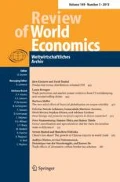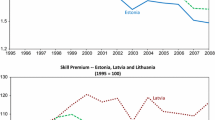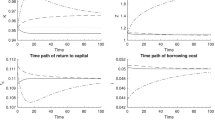Abstract
Trade with Asia and Skill Upgrading: Effects on Factor Markets in the Older Industrial Countries. — The trade and labor nexus is examined with a model incorporating refinements which weaken the H-O-S result that free trade can cause factor rewards to equalize. Asian growth and rising openness in the period 1970–1992, taken in isolation, are found to cause real wages to rise there, even for production workers. Although they also cause increased wage dispersion, the magnitude is small compared with the effects of skill upgrading. Projections to 2010, which combine further expansion in imports from Asia with continued Northern skill upgrading, yield declining real wages and/or unemployment for both production and farm workers. Restricting imports from Asia is found to be an ineffective response.
Zusammenfassung
Handel mit Asien und Höherqualifizierung. Auswirkun-gen auf die Faktormärkte in den älteren Industrieländern. — Das verwendete Modell enthält einige Verfeinerungen, die die Implikationen des H-O-S-Modells abschwächen, wonach Freihandel dazu führt, daß sich die Faktorentlohnungen der einzelnen Länder angleichen. Wenn man das Wachstum in Asien und die zunehmende Offenheit in der Zeit von 1970–1992 isoliert betrachtet, dann stellt sich heraus, daß dies den Ländern auf der nördlichen Halbkugel Nettovorteile gebracht hat. Dort stiegen die Reallöhne sogar für Industriearbeiter. Projektionen für das Jahr 2010, die einen weiteren Anstieg der Importe aus Asien mit fortgesetzter Höherqualifizierung der Arbeitskräfte im Norden kombinieren, ergeben sinkende Reallöhne und/oder Arbeitslosigkeit für Arbeiter sowohl in der Industrie als auch in der Landwirtschaft. Importbeschränkungen gegenüber Asien erweisen sich als ungeeignet.
Similar content being viewed by others
References
Anderson, K. (1994). Food Price Policy in East Asia.Asia-Pacific Economic Literature 8(2): 15–30.
Anderson, K., and Y. Hayami (1986).The Political Economy of Agricultural Protection: East Asia in an International Perspective. Sydney: Allen and Unwin.
Berman, E., J. Bound, and Z. Griliches (1994). Changes in the Demand for Skilled Labor within U.S. Manufacturing: Evidence from the Annual Survey of Manufactures.Quarterly Journal of Economics 109(2): 367–397.
Borjas, G. J., and V. A. Ramey (1994). The Relationship between Wage Inequality and International Trade. In J. H. Bergtrand, T. F. Cosimano, J. W. Houk and R. G. Sheehan (eds.),The Changing Distribution of Income in an Open US Economy. Amsterdam: North-Holland.
Bound, J., and G. Johnson (1992). Changes in the Structure of Wages in the 1980s: An Evaluation of Alternative Explanations.American Economic Review 82(3): 371–392.
Brown, D. K., and R. M. Stern (1989). US-Canada Bilateral Tariff Elimination: The Role of Product Differentiation and Market Structure. In R. C. Feenstra (ed.),Track Policies for International Competitiveness. Chicago: University of Chicago Press.
Caddy, V. (1976). Empirical Estimation of the Elasticity of Substitution: A Review. Impact Project Working Paper OP-09, Monash University, Melbourne.
Campbell, N., and N. Vousden (1995). Import Competition and X-Efficiency in Unionized Firms. Mimeo. Department of Economics, Australian National University.
Deardorff, A. (1986). FIRless and FIRwoes: How Preferences can Interfere with the Theorems of International Trade.Journal of International Economics 20(1): 131–142.
Dervis, K., J. de Melo, and S. Robinson (1982).General Equilibrium Models for Development Policy. New York: Cambridge University Press.
Dixit, A. K., and R. S. Pindyck (1994).Investment Under Uncertainty. Princeton, N.J.: Princeton University Press.
Drysdale, P., and R. Garnaut (1994). Trade Intensities and the Analysis of Bilateral Trade Flows in a Many-Country World: A Survey. In R. Garnaut and P. Drysdale (eds.),Asia-Pacific Regionalism: Readings in International Economic Relations. Sydney: Harper Educational Publishers.
Ethier, W. (1984). Higher Dimensional Issues in Trade Theory. In R. W. Jones and P. B. Kenen (eds.),Handbook of International Economics, Vol. I. Amsterdam: North-Holland.
Falvey, R. (1997). Trade Liberalization and Factor Price Convergence. Forthcoming inJournal of International Economics.
Falvey, R., R. Tyers, and R. McDougall (1997). Trade Shocks and the Magnitude of Transmitted Wage Adjustments. Working Papers in Economics and Econometrics 318. Faculty of Economics and Commerce, Australian National University.
Fecher, F., and S. Perelman (1992). Productivity Growth and Technical Efficiency in OECD Industrial Activities. In R. E. Caves (ed.),Industrial Efficiency in Six Nations. Cambridge, Mass.: MIT Press.
Feenstra, R. C., and G. H. Hanson (1995). Globalization, Outsourcing, and Wage Inequality.American Economic Review 86(2): 240–245.
Gehlhar, M. (1994). Economic Growth and Trade in the Pacific Rim: An Analysis of Trade Patterns. Unpublished doctoral dissertation, Purdue University.
Gehlhar, M., T. Hertel, and W. Martin (1994). Economic Growth and the Changing Structure of Trade and Production in the Pacific Rim.American Journal of Agricultural Economics 76 (5): 1101–1110.
Hamermesh, D. S. (1992).Labor Demand. Princeton, N. J.: Princeton University Press.
Hayami, Y., and V. W. Ruttan (1985).Agricultural Development: An International Perspective. Baltimore: Johns Hopkins University Press.
Hertel, T. W. (ed.) (1997).Global Trade Analysis: Modeling and Applications. New York: Cambridge University Press.
Hertel, T. W., and M. E. Tsigas (1997). Structure of GTAP. In T. W. Hertel (ed.),Global Trade Analysis: Modeling and Applications. New York: Cambridge University Press.
Hertel, T. W., W. Martin, K. Yanagishima, and B. Dimaranan (1996). Liberalizing Manufactures Trade in a Changing World Economy. Chapter 7 inThe Uruguay Round and the Developing Countries. New York: Cambridge University Press.
Hertel, T. W., E. B. Peterson, P. V. Preckel, Y. Surry, and M. E. Tsigas (1991). Implicit Additivity as a Strategy for Restricting the Parameter Space in CGE Models.Economic and Financial Computing 1 (1): 265–287.
Horridge, M. (1987). The Long-term Costs of Protection: Experimental Analysis with Different Closures of an Australian Computable General Equilibrium Model. Doctoral dissertation, Department of Economics, University of Melbourne.
Huff, K., K. Hanslow, T. W. Hertel, and M. E. Tsigas (1997). GTAP Behavioural Parameters. In T. W. Hertel (ed.),Global Trade Analysis: Modeling and Applications. New York: Cambridge University Press.
IMF (1993).World Economic Outlook. Washington, D.C.: International Monetary Fund.
Jones, R. W. (1971). A Three-Factor Model in Theory, Trade and History. In J. Bhagwati et al. (eds.)Trade, Balance of Payments and Growth. Amsterdam: North-Holland.
Jorgenson, D. W. (1984). Econometric Methods for Applied General Equilibrium Analysis. In H. E. Scarf and J. B. Shoven (eds.),Applied General Equilibrium Analysis. New York: Cambridge University Press.
Krueger, A. (1968) Factor Endowments and Per Capita Income Differences among Countries.Economic Journal 78 (September): 641–659.
— (1977).Growth, Distortions and Patterns of Trade Among Many Countries. Princeton, N.J.: International Finance Section.
Lawrence, R. Z., and M. J. Slaughter (1993). Trade and US Wages: Great Sucking Sound or Small Hiccup?Brookings Papers on Economic Activity: Microeconomics: 161–210.
Learner, E. E. (1994). Trade, Wages and Revolving Door Ideas. NBER Working Paper 4716. Cambridge, Mass.
Martin, W., and D. Mitra (1993). Technical Progress in Agriculture and Manufacturing. Mimeo. IECIT World Bank, Washington, D. C.
McDougall, R., and R. Tyers (1993). Developing Country Expansion and Factor Markets in Industrial Countries. Presented at the special session on GTAP applications, International Agricultural Trade Research Consortium Annual Meeting, San Diego, California, December 12–14, 1993.
— (1994). Developing Country Expansion and Labor-Saving Technical Change: Factor Market Effects and Policy Reactions.American Journal of Agricultural Economics 76(5): 1111–1119.
— (1997). Developing Country Expansion and Relative Wages in Industrial Countries. In T. W. Hertel (ed.),Global Trade Analysis Using the GTAP Model. New York: Cambridge University Press.
Mezzetti, C., and E. Dinopolous (1991). Domestic Unionization and Import Competition.Journal of International Economics, 31 (1/2): 79–100.
Mincer, J. (1991). Human Capital, Technology and the Wage Structure: What Do the Time Series Show? NBER Working Paper 3851. Cambridge, Mass.
Nehru, V., and A. Dhareshwar (1993). New Estimates of Total Factor Productivity Growth for Eighty-Three Industrial and Developing Countries. World Bank Policy Working Paper 1128. World Bank, Washington, D. C.
Powell, A. A., D. J. Parham, D. C. Sams, H. C. Hiep, and R. J. Rimmer (1984). A Wage-Responsive Disaggregation of Labor Supply. Impact Project Working Paper B-33, Faculty of Economics and Commerce, University of Melbourne.
Rimmer, M. (1991). Primary Factor Substitution and the Real Wage Explosions.Australian Economic Papers 30 (December): 316–333.
Summers, R., and A. Heston (1991). The Penn World Tables (Mark 5): An Expanded Set of International Comparisons, 1950–1988.Quarterly Journal of Economics, 106 (2): 327–368.
Tinbergen, J. (1975). Substitution of Academically Trained by Other Manpower.Weltwirtschaftliches Archiv 111(3):466–476.
Vo, T. T., and R. Tyers (1995). Splitting Labor by Occupation in GTAP: Sources and Assumptions. Project Paper 3, LDC Trade and DC Wage Dispersion Project, Department of Economics, The Faculties, Australian National University.
Wood, A. (1994).North-South Trade, Employment and Inequality. Oxford: Clarendon Press.




